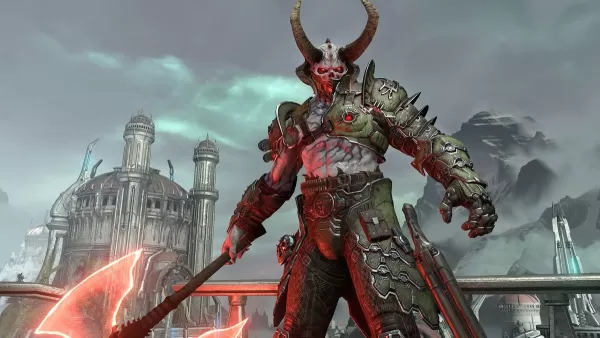When director Hugo Martin unveiled the mantra "stand and fight" for Doom: The Dark Ages during Xbox's Developer Direct earlier this year, it immediately caught my attention. This concept starkly contrasts with id Software's previous title, Doom Eternal, which thrived on fast-paced, constantly moving combat. However, Doom Eternal introduced an enemy that embodies this new mantra—the Marauder. A polarizing figure in the Doom community, the Marauder is detested by many, yet cherished by me. The realization that the key to combat in Doom: The Dark Ages involves reacting to bright green lights—just like with the Marauder—sealed my enthusiasm for the game.
Rest assured, The Dark Ages doesn't trap you in a frustrating duel with an enemy as relentless as Eternal's Marauder. While the Agaddon Hunter, with its bulletproof shield and lethal combo attacks, presents a challenge, it's the broader combat design that echoes Eternal's legacy. The essence of the Marauder's mechanics has been reimagined and integrated into the core gameplay of The Dark Ages, ensuring every encounter feels strategic and rewarding, without the irritation.
The Marauder is a unique adversary in Doom Eternal. Typically, fights in Eternal involve circling the arena, slicing through lesser enemies and juggling between larger threats. Eternal often feels like a management game, requiring you to juggle speed, space, and weaponry. However, the Marauder disrupts this flow, demanding undivided attention, often in isolated battles. When it appears in larger skirmishes, the strategy shifts to evading its attacks, clearing other enemies, and then confronting it head-on.
 Doom Eternal's Marauder is one of the most controversial enemies in FPS history. | Image credit: id Software / Bethesda
Doom Eternal's Marauder is one of the most controversial enemies in FPS history. | Image credit: id Software / Bethesda
Standing still isn't what "stand and fight" means in Doom Eternal; it's about controlling the battlefield through strategic positioning. Too close, and the Marauder's shotgun blast is nearly unavoidable. Too far, and you're out of range for his vulnerable axe swing. The key is to be in the perfect spot to exploit the brief moment his guard drops during his axe attack, signaled by his eyes flashing bright green—a signal to strike.
Similarly, in Doom: The Dark Ages, bright green flashes are your cue. In a homage to the original Doom, enemies unleash barrages of projectiles, within which are green missiles that can be parried with the Doom Slayer's new shield, sending them back to their source. Initially, this is a defensive maneuver, but as you unlock the shield's rune system, it becomes a potent offensive tool, stunning enemies or triggering an auto-targeting cannon.
Navigating the battlefields of The Dark Ages involves a series of one-on-one encounters with formidable foes. Unlike the Marauder's confrontations, survival here isn't solely reliant on green light reactions. Your conventional weapons and tactics can lead you to victory, but the shield's runes elevate parrying to a crucial part of your arsenal. Integrating this into your combat strategy reveals parallels with the Marauder fights of Eternal. You need to find the optimal distance and timing to parry those green orbs, much like timing the Marauder's axe swing. This requires focus, transforming your journey into a series of intense, focused battles where you stand and fight.
The Marauder's main criticism was its disruption of Doom Eternal's flow, demanding a different approach than the rest of the game's challenges. This is precisely why I admire the Marauder; it's a breakdance in a game of ballet, challenging the norms of first-person shooters and pushing players to rethink their strategies. While I appreciate the challenge, I understand the frustration it caused many.
 The Agaddon Hunter may be the most Marauder-like enemy in The Dark Ages, but every demon has a little bit of Eternal's most fearsome foe in them. | Image credit: id Software / Bethesda
The Agaddon Hunter may be the most Marauder-like enemy in The Dark Ages, but every demon has a little bit of Eternal's most fearsome foe in them. | Image credit: id Software / Bethesda
Doom: The Dark Ages addresses this by integrating various "dances" into its combat system. Each major enemy type has a unique green projectile or melee attack, requiring a tailored approach. For example, the Mancubus fires energy "fences" with green "pillars" at the ends, necessitating precise movement to parry. The Vagary sends volleys of spheres that you must sprint toward to deflect, while the Revenant closely mimics the Marauder, becoming vulnerable only after you deflect its green skulls.
With each demon demanding unique tactics, new enemies feel less jarring. The Agaddon Hunter and Komodo introduce challenging melee combos, but by this point, you're adept at adapting. Unlike the Marauder in Eternal, where the game's rules didn't prepare players for its unique challenge, The Dark Ages builds its reaction-based mechanics into the core gameplay from the start.
The Marauder's design wasn't the issue; it was its unexpected disruption of Eternal's established rules. Doom: The Dark Ages prepares you for such encounters by making reaction-based mechanics a fundamental part of the experience. While the challenge may be less intense due to more generous timing windows, the essence of the Marauder—waiting for the right moment to strike when the light turns green—pervades every battle. Doom: The Dark Ages offers a fresh take on these mechanics, yet they remain unmistakably connected. You stand and you fight.







![NULL [Remastered]](https://imgs.39man.com/uploads/71/1719651062667fcaf6c483b.png)








